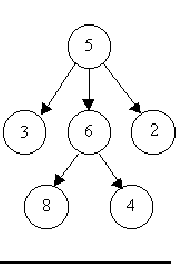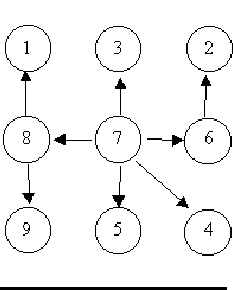hdu1325 Is It A Tree? (并查集+森林)
2015-11-19 17:58
459 查看
Is It A Tree?
Time Limit: 2000/1000 MS (Java/Others) Memory Limit: 65536/32768 K (Java/Others)Total Submission(s): 18771 Accepted Submission(s): 4189
Problem Description
A tree is a well-known data structure that is either empty (null, void, nothing) or is a set of one or more nodes connected by directed edges between nodes satisfying the following properties.
There is exactly one node, called the root, to which no directed edges point.
Every node except the root has exactly one edge pointing to it.
There is a unique sequence of directed edges from the root to each node.
For example, consider the illustrations below, in which nodes are represented by circles and edges are represented by lines with arrowheads. The first two of these are trees, but the last is not.



In this problem you will be given several descriptions of collections of nodes connected by directed edges. For each of these you are to determine if the collection satisfies the definition of a tree or not.
Input
The input will consist of a sequence of descriptions (test cases) followed by a pair of negative integers. Each test case will consist of a sequence of edge descriptions followed by a pair of zeroes Each edge description will consist of a pair of integers;
the first integer identifies the node from which the edge begins, and the second integer identifies the node to which the edge is directed. Node numbers will always be greater than zero.
Output
For each test case display the line ``Case k is a tree." or the line ``Case k is not a tree.", where k corresponds to the test case number (they are sequentially numbered starting with 1).
Sample Input
6 8 5 3 5 2 6 4
5 6 0 0
8 1 7 3 6 2 8 9 7 5
7 4 7 8 7 6 0 0
3 8 6 8 6 4
5 3 5 6 5 2 0 0
-1 -1
Sample Output
Case 1 is a tree.
Case 2 is a tree.
Case 3 is not a tree.
Source
North Central North America 1997
Recommend
Ignatius.L | We have carefully selected several similar problems for you: 1856 1232 1233 1102 1875
解析:1.0 0 输出true
2.并查集判断所有输入数据组成一个生成树(先将边看做无向的)
3.用ru[x]记录是否有其他点指向点x,并且保证ru[i]==0的 i 只有一个(也就是生成树的根,因为是有向边,繁殖出现这种情况:1 2 3 2 0 0)
代码:
#include<cstdio>
#include<cstring>
#include<algorithm>
#define ms(a) memset(a,0,sizeof(a))
using namespace std;
const int maxn=1e5;
int f[maxn+10];
bool used[maxn+10],ru[maxn+10];
int find(int x)
{
if(f[x]==x)return x;
return f[x]=find(f[x]);
}
int main()
{
freopen("1.in","r",stdin);
int x,y,rx,ry,l=maxn,r=1,s=1;
bool flag=1;ms(used),ms(ru);
while(scanf("%d%d",&x,&y),x>=0)
{
if(x==0 && y==0)
{
for(x=l,y=0;x<=r;x++)
if(used[x] && f[x]==x)y++;
flag=(flag&&y<=1);
for(x=l,y=0;x<=r;x++)
if(used[x] && !ru[x])y++;
flag=(flag&&y<=1);
if(flag)printf("Case %d is a tree.\n",s);
else printf("Case %d is not a tree.\n",s);
ms(used),ms(ru),flag=1,l=maxn,r=1,s++;
continue;
}
ru[y]=1;
if(used[x])rx=find(x);
else rx=f[x]=x,used[x]=1;
if(used[y])ry=find(y);
else ry=f[y]=y,used[y]=1;
if(rx!=ry)f[rx]=ry;else flag=0;
l=min(l,min(x,y)),r=max(r,max(x,y));
}
return 0;
}
相关文章推荐
- 10+年程序员总结的20+条经验教训
- android span相关
- Disk Storage(微软笔试)
- Linux下Java Web服务器搭建3(YUM配置)
- 南大软院大神养成计划第四天
- Objective-C Runtime 运行时之三:方法与消息
- SSL_TLS
- 预处理语句占位符的使用
- 预处理语句占位符的使用
- HTML5中表单的创建
- BugPhobia贡献篇章:团队贡献分值与转会确定
- where 泛型类型参数及约束
- CodeForces 540C Ice Cave (BFS)
- 使用RDS必须知道的几点
- haproxy详解
- 单文档添加按钮
- NGUI Tween几种用法随手记
- Hadoop文件系统元数据fsimage和编辑日志edits
- 第7章 对表单和数据表格应用样式
- linux工具使用
